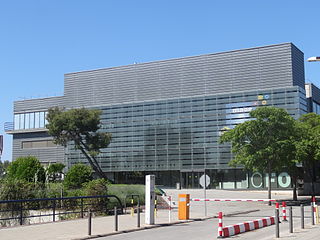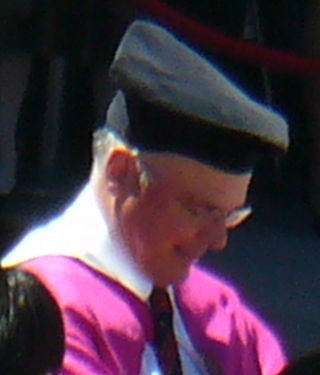Optica is a professional society of individuals and companies with an interest in optics and photonics. It publishes journals and organizes conferences and exhibitions. It currently has about 488,000 customers in 183 countries, including nearly 300 companies.

Gérard Albert Mourou is a French scientist and pioneer in the field of electrical engineering and lasers. He was awarded a Nobel Prize in Physics in 2018, along with Donna Strickland, for the invention of chirped pulse amplification, a technique later used to create ultrashort-pulse, very high-intensity (petawatt) laser pulses.
Julio César Gutiérrez Vega is a Mexican physicist who has done pioneering work on wave propagation of optical fields; in particular, he introduced the Mathieu family of non-diffracting optical beams and the Helmholtz-Gauss beams —a parabolic family of non-diffracting optical beams— with Miguel A. Bandrés. His research work is done with the Monterrey Institute of Technology and Higher Education’s Optics Center, of which he is the director. This work has been recognized with membership in Mexican Academy of Sciences and Level III membership in the Sistema Nacional de Investigadores.

ICFO – The Institute of Photonic Sciences is a research center devoted to the science and technology of light. Located in Castelldefels, ICFO was created in 2002 by the Government of Catalonia and the Technical University of Catalonia.

The University of Arizona College of Optical Sciences, considered the largest institute for optics education in the United States, is dedicated to research and education in optics with an emphasis on optical engineering. The college offers more than 90 courses in optical sciences, and a Bachelor of Science degree in Optical Sciences and Engineering, Masters and Doctoral degree programs in Optical Sciences, as well as a dual master's degree in Optical Sciences and Business Administration. The college also offers comprehensive distance learning courses leading to a Professional Graduate Certificate or a master's degree and markets non-credit short courses on DVD to optics professionals.

Joseph Henry Eberly is the Andrew Carnegie Professor of Physics and Professor of Optics at the University of Rochester.
Satoshi Kawata is a scientist based in Japan who is active in nanotechnology, photonics, plasmonics, and other areas of applied physics. He is a Professor of Department of Applied Physics at Osaka University. He is also a Chief Scientist at RIKEN. Kawata is the president of Optica, 2022.
Eric Van Stryland was president of the Optical Society of America in 2005.

Susan Nicole Houde-Walter is an academic and technical executive in the field of optics. She was Professor of Optics at the University of Rochester from 1987-2005. She is now running LaserMaxDefense, a manufacturer of laser equipment for military and law enforcement. She served as president of the Optical Society in 2005 and has travelled extensively with the US military. Currently, she is the Director of the Chester F. Carlson Center for Imaging Science at the Rochester Institute of Technology.
Anthony Michael Johnson is an American experimental physicist, a professor of physics, and a professor of computer science and electrical engineering at the University of Maryland, Baltimore County (UMBC). He is the Director of the Center for Advanced Studies in Photonics Research (CASPR), also situated on campus at UMBC. Since his election to the 2002 term as president of the Optical Society, formerly the Optical Society of America, Johnson has the distinction of being the first and only African-American president to date. Johnson's research interests include the ultrafast photophysics and nonlinear optical properties of bulk, nanostructured, and quantum well semiconductor structures, ultrashort pulse propagation in fibers and high-speed lightwave systems. His research has helped to better understand processes that occur in ultrafast time frames of 1 quadrillionth of a second. Ultrashort pulses of light have been used to address technical and logistical challenges in medicine, telecommunications, homeland security, and have many other applications that enhance contemporary life.
Robert Alfano is an Italian-American experimental physicist. He is a Distinguished Professor of Science and Engineering at the City College and Graduate School of New York of the City University of New York, where he is also the founding Director of the Institute for Ultrafast Spectroscopy and Lasers (1982). He is a pioneer in the fields of Biomedical Imaging and Spectroscopy, Ultrafast lasers and optics, tunable lasers, semiconductor materials and devices, optical materials, biophysics, nonlinear optics and photonics; he has also worked extensively in nanotechnology and coherent backscattering. His discovery of the white-light supercontinuum laser is at the root of optical coherence tomography, which is breaking barriers in ophthalmology, cardiology, and oral cancer detection among other applications. He initiated the field known now as Optical Biopsy

Carlos Henrique de Brito Cruz, born in Rio de Janeiro on July 19, 1956, is one of Brazil's most noted physicists and a member of the Brazilian Academy of Sciences. The scientific director of the São Paulo Research Foundation (FAPESP) and a full professor of quantum electronics at the Gleb Wataghin Physics Institute at the State University of Campinas (UNICAMP), Brito Cruz is engaged in research in which he uses femtosecond lasers to study ultrafast phenomena.

David A. B. Miller is the W. M. Keck Foundation Professor of Electrical Engineering at Stanford University, where he is also a Professor of Applied Physics by courtesy. His research interests include the use of optics in switching, interconnection, communications, computing, and sensing systems, physics and applications of quantum well optics and optoelectronics, and fundamental features and limits for optics and nanophotonics in communications and information processing.

Donna Theo Strickland is a Canadian optical physicist and pioneer in the field of pulsed lasers. She was awarded the Nobel Prize in Physics in 2018, together with Gérard Mourou, for the practical implementation of chirped pulse amplification. She is a professor at the University of Waterloo in Ontario, Canada.
Govind P. Agrawal is an Indian American physicist and a fellow of Optica, Life Fellow of the IEEE, and Distinguished Fellow of the Optical Society of India. He is the recipient of James C. Wyant Professorship of Optics at the Institute of Optics and a professor of physics at the University of Rochester. He is also a Distinguished scientist at the Laboratory for Laser Energetics (LLE) in the University of Rochester. Agrawal has authored and co-authored several highly cited books in the fields of non-linear fiber optics, optical communications, and semiconductor lasers.

Hatice Altug is a Turkish physicist and professor in the Bioengineering Department and head of the Bio-nanophotonic Systems laboratory at École Polytechnique Fédérale de Lausanne (EPFL), in Switzerland. Her research focuses on nanophotonics for biosensing and surface enhanced spectroscopy, integration with microfluidics and nanofabrication, to obtain high sensitivity, label-free characterization of biological material. She has developed low-cost biosensor allowing the identification of viruses such as Ebola that can work in difficult settings and therefore particularly useful in case of pandemics.
Peter J. Delfyett Jr is an American engineer and Pegasus Professor and Trustee Chair Professor of Optics, ECE & Physics at the University of Central Florida College of Optics and Photonics.

Debabrata Goswami FInstP FRSC, is an Indian chemist and the Prof. S. Sampath Chair Professor of Chemistry, at the Indian Institute of Technology Kanpur. He is also a professor of The Department of Chemistry and The Center for Lasers & Photonics at the same Institute. Goswami is an associate editor of the open-access journal Science Advances. He is also an Academic Editor for PLOS One and PeerJ Chemistry. He has contributed to the theory of Quantum Computing as well as nonlinear optical spectroscopy. His work is documented in more than 200 research publications. He is an elected Fellow of the Royal Society of Chemistry, Fellow of the Institute of Physics, the SPIE, and The Optical Society. He is also a Senior Member of the IEEE, has been awarded a Swarnajayanti Fellowship for Chemical Sciences, and has held a Wellcome Trust Senior Research Fellowship. He is the third Indian to be awarded the International Commission for Optics Galileo Galilei Medal for excellence in optics.
Alexander Luis Gaeta is an American physicist and the David M. Rickey Professor of Applied Physics at Columbia University. He is known for his work on quantum and nonlinear photonics. He is a Fellow of the American Physical Society, Optica, and of the Institute of Electrical and Electronics Engineers.

Igor Meglinski is a British, Finnish, New Zealand physicist, scientist, and biomedical engineer best known for his development of fundamental studies and translation research dedicated to imaging of cells and biological tissues utilising polarised light, dynamic light scattering and computational imitation of light propagation within complex tissue-like scattering medium.











